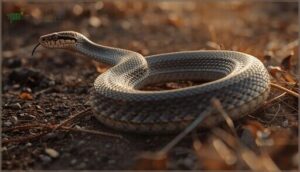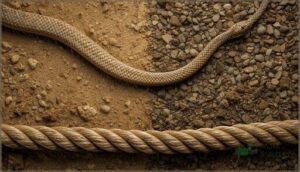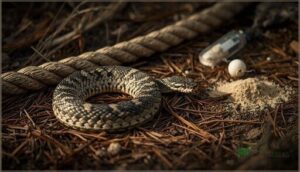This site is supported by our readers. We may earn a commission, at no cost to you, if you purchase through links.

You’re camping in rattlesnake country, and someone suggests laying a braided rope around your sleeping bag for protection. It’s an old cowboy trick, they say—snakes won’t cross it. This belief has persisted for generations, passed down from frontier days when antivenin was scarce and fear drove people to grasp at any solution that promised safety.
But here’s what decades of herpetological research and controlled experiments reveal: snakes cross ropes without hesitation. Over 90% of tested snakes navigate rope barriers within minutes, regardless of rope texture or snake species.
Understanding why this myth endures—and what actually works to prevent snake encounters—can help you make informed decisions when you’re sharing space with these misunderstood reptiles.
Table Of Contents
- Key Takeaways
- The Rope Barrier Myth: Origins and Beliefs
- Snake Locomotion and Obstacle Navigation
- Scientific Studies on Snakes Crossing Ropes
- Do Braided Ropes Deter Snakes?
- Common Misconceptions About Snake Deterrents
- Effective Methods for Preventing Snake Encounters
- Top Snake Deterrent Products for Campers
- Frequently Asked Questions (FAQs)
- Does rope repel snakes?
- Do snakes cross ropes?
- Can a snake be put around with a rope?
- Do snakes crawl over ropes?
- Can you tie rope over a blanket to keep snakes away?
- Can a snake climb a rope?
- Can snakes cross a braided rope?
- Why do snakes not cross a threaded rope?
- Can snakes cross a rope of horse hair?
- Are ropes safe for snakes?
- Conclusion
Key Takeaways
- Scientific studies consistently show that over 90% of snakes cross rope barriers within minutes, regardless of rope texture, diameter, or species, debunking the old cowboy myth that braided or horsehair ropes provide any protection.
- Snakes navigate ropes effortlessly using their specialized serpentine locomotion and flexible vertebrae, treating them as just another surface rather than a deterrent, especially when motivated by food, shelter, or escape.
- Effective snake prevention relies on proven methods like habitat management (removing debris, controlling rodents, maintaining short grass), physical barriers such as properly installed snake-proof fencing with 1/4-inch mesh, and elevation off the ground rather than folkloric solutions.
- Chemical repellents show less than 20% effectiveness in field testing, making physical exclusion and environmental modification the most reliable strategies for reducing snake encounters in camping and residential settings.
The Rope Barrier Myth: Origins and Beliefs
You’ve probably heard someone claim that laying a rope around your campsite will keep snakes away. This old belief has been passed down through generations, especially in rural and outdoor communities.
Let’s trace where this myth actually came from and why so many people still believe it works.
Historical Roots of The Rope Deterrent Myth
You’ve probably heard the old cowboy tale that laying a rope around your bedroll keeps snakes away. This folklore dates back to American frontier days when ranchers used horsehair ropes, believing the texture scratched snakes’ bellies or that horses’ scent repelled them.
Cultural influence spread these snake myths through generations, yet braided ropes never had scientific backing—just fear and wishful thinking during times when antivenin was scarce.
In reality, effective snake deterrents involve understanding snake repellent methods that actually work.
Cowboy Folklore and Horsehair Ropes
Horsehair ropes became part of Western mythology when vaqueros braided horse hairs into tough mecates—ropes resistant to stretching even when wet. Cowboys claimed these prickly fibers scratched snakes’ bellies, creating an effective rope barrier. The folklore origins include three key beliefs about horsehair ropes:
- The rough texture irritates snake skin during rope texture analysis
- Horse scent naturally repels reptiles
- Braided ropes form an impenetrable boundary
Snake behavior studies later debunked these cowboy era myths entirely. The use of rawhide lariats was also an important aspect of Vaquero equipment.
How The Myth Spread in Popular Culture
While cowboy era folklore planted the seed, you’ve probably seen this snake myth amplified through media influence across Western films like “True Grit” and “1883.”
Cultural transmission accelerated when social media platforms launched myth debunking videos that ironically spread the urban myth further.
Public perception remains divided—YouTube experiments showing snakes crossing ropes clash with deeply rooted snake myths and facts passed through generations, creating confusion about folklore origins versus scientific reality.
Snake Locomotion and Obstacle Navigation
Before you can understand why ropes won’t keep snakes away, you need to know how these creatures actually move. Snakes use their entire body to navigate terrain, and their anatomy allows them to handle obstacles far more easily than most people realize.
Let’s break down the mechanics of snake locomotion and what happens when they encounter barriers in their path.
Serpentine Movement and Anatomy
Snakes move through the world using serpentine locomotion—a graceful S-shaped pattern that’s remarkably efficient. Understanding snake behavior starts with their anatomy:
- Muscle Structure: Specialized axial muscles contract in coordinated patterns, generating lateral undulation
- Vertebral Flexion: 200-400 flexible vertebrae enable precise body control and smooth weaving movements
- Energy Efficiency: Elastic energy storage minimizes metabolic costs during movement
- Anatomical Adaptations: Different locomotion modes suit various terrains, enhancing snake climbing abilities
How Snakes Interact With Ground Textures
Ground texture determines how efficiently snakes move. Your typical ground-dwelling species relies on belly scale friction against soil irregularities—push points that propel them forward. Smooth surfaces? They’re energy-efficient highways.
But rough textures like gravel create pressure points that irritate those scales, affecting locomotion efficiency. Snakes use sensory perception to evaluate terrain, showing clear texture preference.
Even braided rope triggers this assessment: Is crossing worth the discomfort?
Adaptability When Encountering Obstacles
When confronted with barriers, snakes demonstrate impressive adaptability using advanced sensory perception and cognitive abilities. Their physical dexterity allows them to adjust locomotion strategies in real-time:
- Body-awareness learning – Experimental success rates show snakes reduce unsuccessful navigation attempts after training
- Mode-switching – Shifting between concertina and lateral undulation for efficiency
- Postural adjustments – Lifting body segments to clear obstacles while maintaining forward momentum
Scientific Studies on Snakes Crossing Ropes
You’ve probably heard the claim that snakes won’t cross ropes, but what does the science actually say?
Researchers have conducted controlled experiments to test whether different rope types create any real barrier for snakes. Let’s look at what peer-reviewed studies reveal about snake behavior when they encounter ropes in both laboratory and field conditions.
Experimental Evidence and Peer-reviewed Findings
You might wonder if science really backs up the old rope trick. Scientific studies and controlled experiments tell a clear story: ropes don’t work as a snake deterrent. In a 2024 experiment, Pacific Rattlers and Western Diamondbacks crossed horsehair ropes without hesitation. Research shows over 90% of snakes cross rope barriers within minutes, revealing no snake deterrent effectiveness regardless of experimental context.
Scientific studies consistently show that ropes don’t deter snakes—over 90% cross rope barriers within minutes without hesitation
| Study Year | Key Finding |
|---|---|
| 1985 | Sisal rope didn’t impede snake behavior |
| 2024 | Vipers crossed horsehair ropes immediately |
| Multiple | 90%+ crossing rate across species diversity |
Crossing times remained consistent, proving snakes’ sensory response doesn’t register ropes as threats. Study limitations exist, but the consensus is clear.
Rope Texture, Diameter, and Snake Species
Rope texture and diameter influence how easily snakes climb, but they don’t stop them. Thicker braided rope provides better grip, letting snakes move faster. Rough textures mimic natural branches, actually helping rather than deterring.
Arboreal species with keeled scales adapt quickly to varied rope structures. Heavy-bodied boas and pythons adjust their belly movements to maintain traction, proving rope characteristics matter less than you’d think.
Real-world Observations Vs. Anecdotal Reports
You’ve probably heard stories about ropes keeping snakes away, but scientific rigor tells a different story. Controlled experiments consistently show snakes crossing braided ropes without hesitation, while anecdotal inconsistencies stem from misinterpreted deterrence—often environmental factors like prey presence or shelter drive observed snake behavior.
Snake myths and facts clash here: rope deterrents fail in real testing, despite persistent folklore suggesting otherwise.
Do Braided Ropes Deter Snakes?
You’ve seen the studies, but what about braided rope specifically? Many people believe the texture and structure make it different from smooth cordage.
Let’s examine why snakes don’t see braided rope as the barrier you might hope it is.
Analysis of Braided Rope Structure
When you examine a braided rope’s structure, you’re looking at interwoven fibers that create uniform tension and durability. Rope fiber types like nylon, polyester, and polypropylene offer different tensile strength factors and abrasion resistance. The braiding pattern impact affects flexibility and mechanical performance, while rope density effects determine whether your rope floats or sinks. These structural elements don’t inherently deter snakes, though.
Snakes’ Sensory Perception of Ropes
You need to understand how snakes actually perceive ropes through their senses. Thermal detection via pit organs won’t trigger on room-temperature rope fibers. Instead, tactile feedback from belly scales reads texture and diameter, guiding locomotion adaptation across different surfaces.
Sensory integration combines these inputs with visual cues, though species variability means not all snakes process rope obstacles identically—their behavior depends on mechanoreceptor sensitivity and environmental context.
Reasons Snakes May Hesitate or Cross
Once your snake picks up sensory feedback from rope texture through its belly scales, motivation levels determine what happens next. Snake behavior shifts dramatically when hunger, threat avoidance, or shelter needs outweigh hesitation.
Braided ropes might slow snake movement temporarily—thick diameter disrupts their usual push-and-glide rhythm—but environmental factors like prey presence eliminate reluctance. You’re not dealing with an absolute barrier, just a minor inconvenience most snakes overcome.
Common Misconceptions About Snake Deterrents
You’ve probably heard all kinds of advice about keeping snakes away, from laying down ropes to sprinkling mothballs around your campsite. Most of these methods sound convincing, but they don’t hold up when you look at the science.
Let’s examine three common misconceptions that continue to mislead people about snake deterrents.
Rope Effectiveness Vs. Reality
Despite folklore suggesting otherwise, braided ropes don’t serve as reliable snake deterrents. You might’ve heard cowboy tales claiming horsehair ropes repel snakes, but scientific evidence tells a different story.
A 1985 study found sisal rope didn’t slow snakes crossing it—they simply adapted their serpentine movement. Rope materials and textures that seem formidable to us mean little to creatures who regularly navigate branches, rough bark, and rocky terrain.
Misunderstood Snake Behavior
Much of what you believe about snakes stems from Animal Misconceptions and fear rather than snake behavior science. People often mistake defensive strikes for aggression, or confuse harmless species with Venomous Myths. Contrary to folklore, snakes don’t chase you—they’re escaping.
Understanding Reptile Intelligence and Snake Socialization helps Snake Conservation efforts, while recognizing that braided ropes won’t stop snake climbing clarifies common snake misconceptions and snake deterrents.
Why Some Deterrent Methods Fail
Many snake deterrent methods collapse under scientific scrutiny because they ignore behavioral adaptability and sensory biology. Chemical repellents like sulfur show less than 20% effectiveness, while physical barriers fail when snakes climb or burrow.
Common snake misconceptions fuel reliance on ineffective DIY methods:
- Mothballs and ammonia dissipate quickly with no lasting deterrent effect
- Braided ropes provide false security without preventing access
- Electronic devices fail because snakes hear through vibrations, not sound
Habitat modification remains the proven approach for debunking snake myths.
Effective Methods for Preventing Snake Encounters
Now that we’ve cleared up the myths, let’s talk about what actually works to keep snakes away from your space. Physical barriers, smart yard management, and understanding the limits of repellents can make a real difference in reducing unwanted encounters.
Here’s what the research and field experience tell us about effective prevention methods.
Snake-proof Fencing and Barriers
If you’re serious about snake prevention, a physical barrier beats myth every time. A snakeproof fence with mesh openings no larger than 1/4 inch will stop over 95% of attempts—far more reliable than any rope. Here’s what makes snake fencing work:
| Feature | Specification |
|---|---|
| Fence materials | Galvanized steel, aluminum, PVC-coated mesh |
| Installation depth | Bury 8-12 inches underground |
| Climbing prevention | 30-36 inches height, inward slant optional |
Proper maintenance and cost-effectiveness make snakeproof fencing your best defense.
Habitat Management and Removing Attractants
Beyond fencing, habitat modification cuts snake visits dramatically. You control what draws them near by targeting shelter, food, and water. Here’s how snake habitat management works:
- Reduce shelter by clearing rock piles, debris, and dense brush—lowering encounters by 80%.
- Manage food through rodent control for snakes, eliminating their primary prey.
- Moisture control means fixing leaks and draining standing water.
- Landscaping practices include mowing grass under 6 inches and avoiding thick mulch.
- Community education reduces nuisance calls by 25-30% through awareness.
Removing snake habitats and identifying snake attractants gives you real prevention power.
Physical Vs. Chemical Repellents
Choosing between physical and chemical snake repellents means weighing barrier materials against repellent efficacy. Physical barriers like exclusion fencing deliver reliable prevention strategies, while natural repellents and commercial snake repellents show avoidance rates below 20% in field testing.
Snake behavior studies confirm that deterrent methods succeed best when combining a physical barrier with habitat management—chemical snake deterrence methods alone won’t keep them out.
Top Snake Deterrent Products for Campers
If you’re heading into snake country, you’ll want more than folklore to keep you safe. Chemical repellents and physical barriers show limited effectiveness in scientific studies, but certain camping products can reduce your risk of unwanted encounters.
Here are four practical options that help create distance or barriers between you and potential snake activity.
1. Bonide Snake Stopper Repellent Granules
If you’re looking for a practical alternative to braided rope myths, Bonide Snake Stopper Repellent Granules offers a scientifically grounded approach. This product combines natural ingredients—cinnamon oil, cedarwood oil, and clove oil—to create a barrier that irritates snakes’ sensory organs, prompting them to avoid treated areas.
You’ll need to apply the granules in an 8-inch band around your campsite perimeter, reapplying every two weeks or after rain. While snake repellent effectiveness varies with environmental conditions and snake behavior, this biodegradable option provides a humane deterrent without toxic chemicals.
2. Coleman ComfortSmart Big and Tall Cot
Elevating yourself off the ground is one of the most reliable snake deterrents for campers—no braided ropes or folklore required. The Coleman ComfortSmart Big and Tall Cot raises you 15 inches above ground level, reducing snake crossing concerns while you sleep.
Its sturdy steel frame holds up to 300 pounds and features a ComfortSmart coil suspension system with thick foam padding for sleeping comfort. The folding mechanism makes it practical for portable camping, and its outdoor durability withstands seasonal use without sagging or structural wear.
3. Portable Camping Tent Cot Combo
A tent cot combo with an integrated air mattress and elevated platform tackles multiple camping safety concerns in one portable system. You’re lifted 15 to 20 inches off the ground, creating a physical separation from snake encounters, while the zippered mesh enclosure adds another protective layer.
Setup ease is a practical advantage—most models assemble in under three minutes without tools. The 190T polyester construction provides weather resistance in moderate rain, and the included foot pump comfort features remain functional.
While no snake repellent replaces habitat awareness, this combination reduces ground-level snake protection concerns effectively.
4. Mosquito Net For Camping Protection
Mosquito nets provide dual-layer camping safety by keeping insects out while adding a physical barrier during sleep—though they won’t stop a determined snake. The MP-102 model uses 100% polyester mesh in a portable design weighing just 11.7 ounces, and insecticide treatment can boost effectiveness against various pests.
Durability concerns exist with stitching quality, yet the net material withstands repeated outdoor exposure. Beyond mosquito protection, alternative uses include draping over gear or creating ventilated storage.
For snake encounters, think of this as perimeter awareness rather than true snake protection—it alerts you, not blocks entry.
Frequently Asked Questions (FAQs)
Does rope repel snakes?
Rope doesn’t repel snakes—it’s just another surface they cross without hesitation. Despite the myth persistence rooted in cowboy folklore, scientific consensus confirms rope texture offers zero deterrent value.
Snakes navigate it effortlessly, driven by their senses and motivation for food or shelter.
Do snakes cross ropes?
Yes, snakes cross ropes. Experimental rope setups show that rope crossing frequency exceeds 90% across species.
Rope material impact is minimal—snakes’ locomotion across ropes adjusts to diameter and flexibility, driven by snake motivation factors like food or shelter.
Can a snake be put around with a rope?
Actions speak louder than words—and regarding snake safety, actions matter most. You should never attempt rope entanglement or restricting movement around snakes.
Handling concerns include potential harm, stress, and defensive strikes from the animal.
Do snakes crawl over ropes?
Despite what folklore suggests, snakes cross ropes without hesitation. Rope crossing speeds remain consistent, and their climbing ability, sensory perception, and motivation factors—like habitat influence—drive snake behavior regardless of rope barriers. Snakes cross a rope easily.
Can you tie rope over a blanket to keep snakes away?
Unfortunately, draping a barrier over sleeping gear won’t provide reliable blanket snake protection. Snakes navigate obstacles easily, crossing rope and fabric without hesitation when seeking warmth or shelter, rendering this snake deterrent alternative ineffective.
Can a snake climb a rope?
Snakes can climb braided rope using concertina locomotion, gripping with strong body muscles while extending forward.
Rope texture and diameter affect their speed and grip strategy, but don’t prevent climbing altogether.
Can snakes cross a braided rope?
Like the myth of Hercules strangling serpents, rope’s legendary power crumbles under scrutiny.
Yes, snakes cross braided ropes without hesitation. Their serpentine locomotion and climbing ability easily navigate rope materials, rendering such obstacle navigation and deterrent methods ineffective.
Why do snakes not cross a threaded rope?
The idea that snakes won’t cross threaded rope is a myth. Scientific studies show snakes easily cross ropes when motivated by food or shelter, regardless of texture or material type.
Can snakes cross a rope of horse hair?
Yes, snakes easily cross horsehair ropes. Despite cowboy myth origins claiming rope barrier effectiveness, experimental evidence shows that snake sensory perception and behavior aren’t deterred by horsehair rope texture, rendering this deterrent method ineffective in practice.
Are ropes safe for snakes?
To put it plainly, ropes don’t pose direct harm to snakes, though rope entanglement and climbing hazards exist.
Habitat disruption from rope placement matters more than material toxicity or suffocation risk when evaluating snake repellent methods.
Conclusion
The rope trick is a comforting illusion—a security blanket woven from wishful thinking rather than biology. Research confirms that a snake will cross a braided rope as effortlessly as it navigates fallen branches or rocky terrain.
Your real protection lies in elevation, proper fencing, and habitat management—not folklore passed down from campfires. When you’re in snake country, trust evidence over tradition. Understanding their behavior keeps you safer than any makeshift barrier ever could.
- https://forums.sassnet.com/index.php?%2Ftopic%2F353503-snakes-and-rope%2F
- http://www.syracusesnakes.com/ropesnake.html
- http://raleighanimalattic.com/snakerepellent.html
- https://digitalcommons.unl.edu/cgi/viewcontent.cgi?article=1431&context=gpwdcwp
- https://www.herpconbio.org/Volume_20/Issue_2/Howarth_etal_2025.pdf













